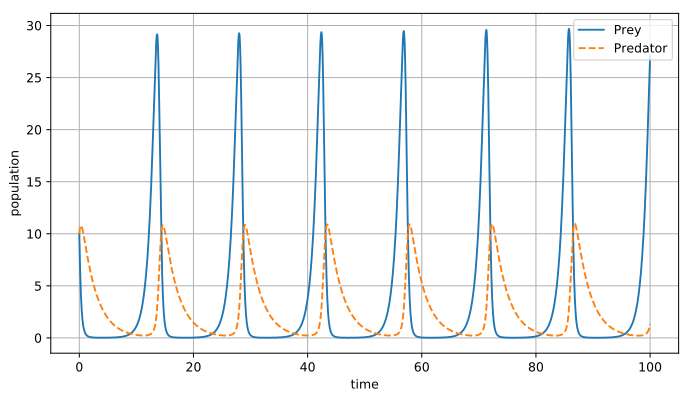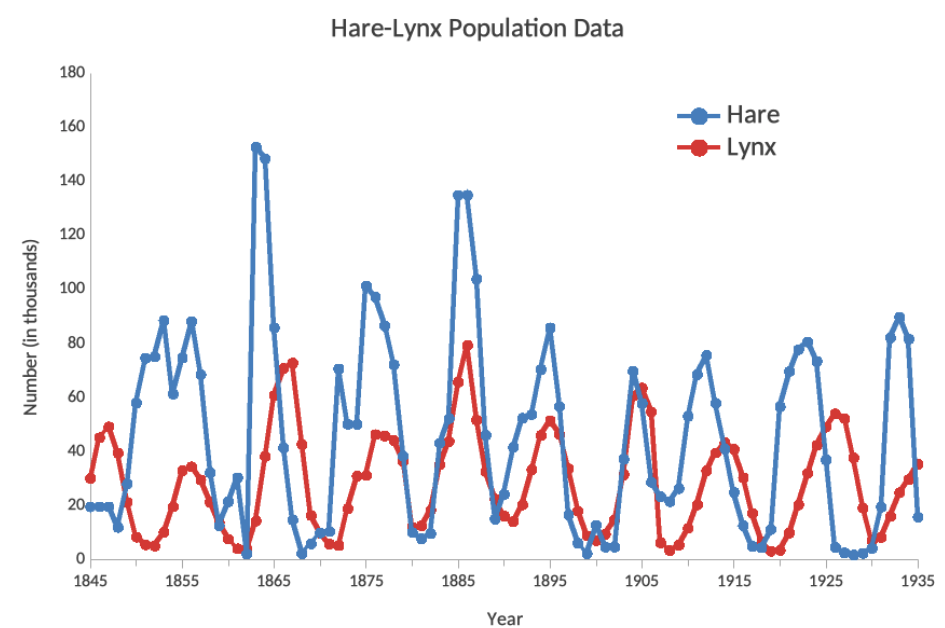OCR Specification focus:
‘Describe predator–prey dynamics and compare interspecific with intraspecific competition, explaining their effects on populations.’
Population interactions determine how species coexist, compete, and evolve within ecosystems. Understanding these relationships helps explain changes in population size, distribution, and community stability.
Predator–Prey Dynamics
Predator–prey relationships are key biotic interactions that regulate population sizes and maintain ecological balance. A predator is an organism that hunts, kills, and consumes another organism, the prey, as a food source.
Predator–prey dynamics typically follow cyclical patterns where fluctuations in one population affect the other. When prey numbers rise, predator populations increase due to abundant food. As predator numbers grow, prey populations decline, followed by a reduction in predator numbers due to food scarcity. This cyclical relationship is often illustrated by the Lotka–Volterra model, which describes oscillations between predator and prey populations over time.

Lotka–Volterra predator–prey oscillations. The prey (solid) rises first, followed by a delayed increase in predators (dashed), producing repeating cycles. This is an idealised model: real populations often deviate due to additional factors. Source.
These dynamics are influenced by several factors:
Reproductive rates of both predator and prey species.
Availability of alternative prey or refuges for prey species.
Carrying capacity of the ecosystem (maximum population size that can be sustained).
Adaptations such as camouflage, mimicry, speed, and defensive mechanisms that improve survival rates.
Predator–prey relationships are examples of density-dependent regulation — population size is controlled by the density of the other species. For example, in the classic case of Lynx and Snowshoe Hare, hare populations increase first, followed by a rise in lynx numbers, and then both decline as predation and food scarcity intensify.

Historical hare–lynx time series (Hudson’s Bay Company records). Peaks in lynx abundance typically lag behind peaks in hare abundance, consistent with predator dependence on prey availability. Note that pelts are a proxy for population size, so the series is approximate. Source.
Competition and Its Types
Competition occurs when organisms vie for the same limited resources such as food, light, water, or territory. It can occur between different species (interspecific) or within a single species (intraspecific).
Competition: The interaction between organisms that seek the same limited resource, reducing the availability of that resource for others.
Competition affects survival, growth, and reproduction, influencing population size and community structure.
Interspecific Competition
Interspecific competition occurs between individuals of different species. It shapes community composition by determining which species can coexist.
Interspecific Competition: Competition between members of different species for the same ecological resources.
Outcomes of interspecific competition include:
Competitive exclusion — one species outcompetes another, potentially leading to local extinction.
Resource partitioning — species evolve to exploit different aspects of a resource, reducing direct competition (e.g., feeding at different times or in different microhabitats).
The competitive exclusion principle (Gause’s principle) states that two species competing for the same limiting resource cannot coexist indefinitely; one will always have a slight advantage and eliminate the other.
For example, Paramecium aurelia and Paramecium caudatum cannot coexist when grown together in the same culture due to direct resource competition, but can coexist if given separate food niches.
Intraspecific Competition
Intraspecific competition occurs among individuals of the same species and plays a crucial role in density-dependent population regulation.
Intraspecific Competition: Competition between individuals of the same species for identical resources within an ecosystem.
This type of competition affects population size by limiting reproduction and survival when resources become scarce. It ensures that only the fittest individuals reproduce, promoting natural selection and genetic adaptation.
Key features of intraspecific competition include:
More intense than interspecific competition because the resource requirements are identical.
Leads to stabilising effects on population size — when numbers increase, competition intensifies, reducing birth rates and increasing mortality.
Encourages territorial behaviour, dominance hierarchies, and dispersal to new habitats to reduce pressure on resources.
For example, oak seedlings growing close together compete for light, water, and nutrients. Only those with advantageous traits or positioning survive to maturity.
Ecological and Evolutionary Implications
Population interactions profoundly affect ecosystem stability and evolutionary processes.
Predation acts as a selective pressure, encouraging the development of better defences (e.g., thorns, toxins, mimicry) in prey and improved hunting adaptations in predators — an evolutionary “arms race.”
Competition drives niche differentiation — species evolve to occupy distinct ecological niches, promoting biodiversity.
Both processes contribute to succession by influencing which species dominate or decline in an ecosystem over time.
Interactions are not always direct; they can involve trophic cascades, where changes in predator populations indirectly affect plants or other lower trophic levels. For example, removing top predators such as wolves from an ecosystem can lead to overgrazing by herbivores and habitat degradation.
Measuring and Modelling Interactions
Ecologists use various models and field methods to study population interactions:
Population sampling — using quadrats or mark–recapture techniques to estimate abundance.
Mathematical models — such as the Lotka–Volterra equations to describe predator–prey oscillations.
EQUATION
—-----------------------------------------------------------------
Lotka–Volterra Predator–Prey Model:
dN/dt = rN − aNP
dP/dt = baNP − mP
Where:
N = prey population size
P = predator population size
r = prey growth rate
a = predation rate coefficient
b = efficiency of converting prey into predator offspring
m = predator mortality rate
—-----------------------------------------------------------------
These equations show that prey population growth (dN/dt) is controlled by both its intrinsic rate of increase and the rate at which predators consume it. Predator population change (dP/dt) depends on prey availability and predator death rate.
While idealised, such models help predict outcomes of population interactions, though real ecosystems are influenced by additional factors such as migration, disease, and human impacts.
Human Influences on Population Interactions
Human activities can profoundly disrupt natural population interactions:
Habitat destruction and fragmentation reduce prey availability and isolate predator populations.
Overhunting or overfishing alters food webs and causes population crashes.
Introduction of invasive species can displace native competitors (e.g., grey squirrels outcompeting red squirrels in the UK).
Conservation programmes aim to restore predator–prey balance, such as the reintroduction of wolves to Yellowstone, which reinstated trophic control and vegetation recovery.
Through understanding predator–prey dynamics and competition, ecologists and conservationists can better manage ecosystems, predict changes, and maintain biodiversity and sustainability within natural and managed environments.
FAQ
Environmental factors such as temperature, rainfall, and habitat availability can alter the balance between predator and prey species.
For example, harsh winters may reduce prey populations, leading to temporary declines in predator numbers. Conversely, warmer conditions might increase prey breeding success and food availability, supporting predator growth.
Human-induced changes—like habitat fragmentation or pollution—can further disrupt these natural cycles, sometimes causing local extinctions or population imbalances.
Prey species have evolved diverse behavioural and physiological defences to survive. Common adaptations include:
Camouflage: blending into surroundings (e.g., stick insects).
Mimicry: resembling harmful organisms to deter predators.
Chemical defences: toxins or unpleasant tastes (e.g., poison dart frogs).
Behavioural strategies: nocturnal activity, herd movement, or alarm calls.
Such adaptations often arise through natural selection, enhancing the survival of individuals better suited to evade predation.
When individuals of the same species compete for limited resources, only those with advantageous traits tend to survive and reproduce.
Over successive generations, these traits become more common in the population, promoting adaptation to environmental pressures.
For example, in a dense plant population, individuals with slightly larger leaves may capture more light, grow faster, and outcompete others—gradually shifting the population’s genetic composition.
Yes. Predators and prey can influence each other’s evolution through reciprocal selection pressures.
As predators develop improved hunting abilities (e.g., sharper eyesight or speed), prey evolve better escape mechanisms (e.g., faster running or cryptic colouration).
This evolutionary “arms race” continues over time, leading to specialised traits on both sides.
Coevolution maintains biodiversity and helps stabilise ecosystems by fostering dynamic but balanced interactions.
When two species compete for similar resources, direct competition often reduces population growth for both.
To reduce conflict, species may gradually exploit different parts of a shared habitat or resource — a process called niche differentiation.
For example, different bird species feeding on the same tree might occupy distinct feeding zones (upper canopy vs lower branches). Over time, these behavioural or morphological differences enable coexistence and reduce competitive exclusion.
Practice Questions
Question 1 (2 marks)
Explain the difference between interspecific and intraspecific competition, giving one example of each.
Mark scheme:
1 mark for correctly defining or distinguishing interspecific competition: competition between members of different species for the same resource.
1 mark for correctly defining or distinguishing intraspecific competition: competition between members of the same species for identical resources.
Accept examples such as lions and hyenas competing for prey (interspecific) and oak seedlings competing for light (intraspecific) as valid supporting evidence, but examples alone cannot score both marks.
Question 2 (5 marks)
Describe how predator–prey population cycles are maintained in a stable ecosystem, and explain why predator population changes typically lag behind prey population changes.
Mark scheme:
1 mark: Prey population increases first when resources are abundant.
1 mark: Predator population increases afterwards due to more food availability.
1 mark: Increased predation causes prey numbers to fall.
1 mark: Predator numbers then decline because of reduced food supply.
1 mark: The time lag occurs because predators reproduce more slowly or require time to respond to changes in prey abundance.
Award up to 5 marks for clear, sequential explanation showing cause-and-effect relationships and understanding of population lag dynamics.

